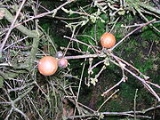
Oak marble gall
Encyclopedia
Oak marble galls develop as a chemically induced distortion of leaf buds on pedunculate oak
(Quercus robur), or sessile oak
(Quercus petraea) trees, caused by the parthenogenetic
gall wasp
(Andricus kollari, (Hartig, 1843)) which lays eggs within leaf buds using their ovipositor
. The Turkey oak
(Quercus cerris), introduced into Britain
in 1735, is required for the completion of the life cycle of the gall. The oak marble gall
is frequently confused with the oak apple
gall, caused by another gall wasp, Biorhiza pallida. Oak marble galls are also known as the bullet gall, oak nut or Devonshire gall. Synonyms for the species are Cynips kollari, Andricus quercusgemmae, A. hispanicus, A. minor, A. indigenus and A. circulans.

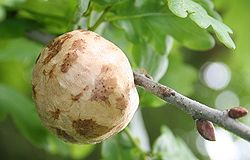 The gall growth first appears as a rounded mass of green plant tissue on the leaf buds of the oak, later becoming hard and brown, being up to approximately 25 mm / 1 in in diameter. Although nearly spherical, the galls often have a number of little flattened nodules. The rounded growths are filled with a spongy mass and a single wasp larva
The gall growth first appears as a rounded mass of green plant tissue on the leaf buds of the oak, later becoming hard and brown, being up to approximately 25 mm / 1 in in diameter. Although nearly spherical, the galls often have a number of little flattened nodules. The rounded growths are filled with a spongy mass and a single wasp larva
is located in a hard seed-like cell in the centre. The word 'marble' derives from the gall's shape, which is a marble-like rounded structure. As stated, although normally distinctive the oak marble gall can, under some growth conditions, be mistaken for the oak apple gall, caused by a number of gall wasps, such as Biorhiza pallida. This may be due to the observer's unfamiliarity with the true oak apple gall which grows to be somewhat larger, has red markings, but does grow on the axillary or terminal buds. The galls sometimes coalesce. The non-parasitised specimens are at the largest end of the size range.
Fused and/or stunted specimens can be confused with A. kollari (Hartig).
from the Middle East in the 1830s.
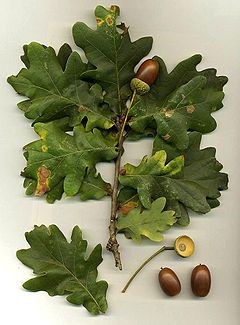
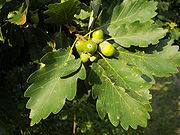 The marble gall has alternating sexual and asexual generations, often taking two years to complete, especially in the north of Britain. The familiar summer gall develops from eggs laid by a sexual female in the developing buds of our two native oaks in May or June; the host trees often being immature or retarded, scrub-oak, specimens; they are rarer on older healthy trees.
The marble gall has alternating sexual and asexual generations, often taking two years to complete, especially in the north of Britain. The familiar summer gall develops from eggs laid by a sexual female in the developing buds of our two native oaks in May or June; the host trees often being immature or retarded, scrub-oak, specimens; they are rarer on older healthy trees.
The developing spherical galls are green at first, brown later, and mature in August. Each gall contains a central chamber, with a single female wasp larva of the asexual generation, which emerges through a 'woodworm-like' hole as an adult winged gall-wasp in September. These asexual (agamic) females lay unfertilized eggs in the embryonic bud leaves of the Turkey oak
, with galls slowly developing during winter, and are visible in March and April as small oval structures between the bud scales, looking like ant's eggs or pupae. The emerging adult gall-wasps in spring are the sexual generation, producing both males and females, which fly to the common oaks to initiate the formation of the summer marble gall.
The abnormal buds develop during summer and the bud is wholly replaced by the gall growth. Marble galls may remain attached to the tree for several years. The level of attack by the insect varies greatly from year to year.
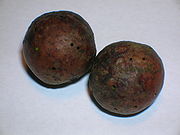 Some herbivorous
Some herbivorous
insects therefore create their own micro-habitats by forming usually highly distinctive plant structures called gall
s, made up of plant tissue but controlled by the insect. Galls act as both the habitat, and food sources for the maker of the gall. The interior of a marble gall, formed from the bud
, is composed of edible and other structural tissues.
Some galls act as "physiologic sinks", concentrating resources in the gall from the surrounding plant parts. Galls may also provide the insect, its parasites and inquiline
s, with a degree of physical protection from predators.

 Mature galls are sometimes broken open by vertebrate predators to recover the larva or pupa. Woodpeckers, such as the lesser spotted woodpecker(Dendrocopus minor), as well as other birds or squirrels have been suggested. In territory of former Czechoslovakia
Mature galls are sometimes broken open by vertebrate predators to recover the larva or pupa. Woodpeckers, such as the lesser spotted woodpecker(Dendrocopus minor), as well as other birds or squirrels have been suggested. In territory of former Czechoslovakia
, both Bank vole
s and yellow-necked mice feed on larvae and pupae extracted from Oak marble galls.
A number of insect inquiline
s live harmlessly within the oak marble gall and some of these, as well as Andricus itself, are parasitised by insects referred to as parasitoids. The chalcid wasp Torymus nitens is an example of a parasitoid in oak marble galls. The presence of these inquilines and parasites is often visible on older galls by the presence of fine exit-holes, smaller than that of the gall wasp itself.
A gall can contain the cynipid wasp as the host that made the gall; up to 5 species of inquilines (Ceroptres clavicornis, Synergus gallaepomiformis, S. pallidipennis, S. reinhardi and S. umbraculus) eating the hosts food; as well as up to 13 parasitoid species (Eurytoma brunniventris, Sycophila biguttata, S. variegata, Megastigmus dorsalis, M. stigmatizans, Torymus geranii, T. auratus, Caenacis lauta, Hobbya stenonota, Mesopolobus amaenus, M. fasciiventris, M. sericeus, Eupelmus urozonus) living on the host, inquilines and each other.
Many old galls bear numerous dark brown excrescences, due to the fungus Phoma gallorum.
 The galls contain large amounts of tannic acid
The galls contain large amounts of tannic acid
, which was used for making iron gall ink and for dyeing cloth. According to recent research, traces of iron-gall ink have been found on the Dead Sea scrolls
and on the 'lost' Gospel of Judas
. Iron-gall ink may have been used for 1,800 years, but it does not withstand the test of time well. Over the course of centuries, the ink fades, and discolours and damages the paper. Other water-proof formulae, better suited for writing on paper, became available in the 20th century. Iron gall ink is manufactured chiefly by artists enthusiastic about reviving old methods or possibly forgers of old documents.
A recipe for preparing the ink is as follows: Take one lb. of bruised galls, one gallon of boiling water, 5½ oz of ferrous sulfate in solution, 3 oz of gum arabic previously dissolved, and a few drops of an anti-septic, such as carbolic acid. Macerate the galls for 24 hours, strain the infusion and add the other ingredients.
British galls have too little tannic acid
(about 17%) for the best results - Aleppo galls have three times as much.
Powdered galls mixed with hog's lard and applied to the posterior were said to be good for curing piles
.
Oak Marble Gall extract is used in deodorants because of tannic acid's anti-bacterial properties.
(fodder) for their pigs.
Pedunculate Oak
Quercus robur is commonly known as the Pedunculate Oak or English oak. It is native to most of Europe, and to Anatolia to the Caucasus, and also to parts of North Africa.-Taxonomy:Q...
(Quercus robur), or sessile oak
Sessile Oak
Quercus petraea , the Sessile Oak, also known as the Durmast Oak, is a species of oak native to most of Europe, and into Anatolia.-Description:...
(Quercus petraea) trees, caused by the parthenogenetic
Parthenogenesis
Parthenogenesis is a form of asexual reproduction found in females, where growth and development of embryos occur without fertilization by a male...
gall wasp
Gall wasp
Gall wasps , also called Gallflies, are a family of the order Hymenoptera and are classified with the Apocrita suborder of wasps in the superfamily Cynipoidea...
(Andricus kollari, (Hartig, 1843)) which lays eggs within leaf buds using their ovipositor
Ovipositor
The ovipositor is an organ used by some animals for oviposition, i.e., the laying of eggs. It consists of a maximum of three pairs of appendages formed to transmit the egg, to prepare a place for it, and to place it properly...
. The Turkey oak
Turkey Oak
Quercus cerris, the Turkey oak is an oak native to southern Europe and Asia Minor. It is the type species of Quercus sect. Cerris, a section of the genus characterised by shoot buds surrounded by soft bristles, bristle-tipped leaf lobes, and acorns that usually mature in 18...
(Quercus cerris), introduced into Britain
Great Britain
Great Britain or Britain is an island situated to the northwest of Continental Europe. It is the ninth largest island in the world, and the largest European island, as well as the largest of the British Isles...
in 1735, is required for the completion of the life cycle of the gall. The oak marble gall
Gall
Galls or cecidia are outgrowths on the surface of lifeforms caused by invasion by other lifeforms, such as parasites or bacterial infection. Plant galls are abnormal outgrowths of plant tissues and can be caused by various parasites, from fungi and bacteria, to insects and mites...
is frequently confused with the oak apple
Oak apple
Oak apple is the common name for a large, round, vaguely apple-like gall commonly found on many species of oak. Oak apples range in size from 2-5cm. Oak apples are caused by chemicals injected by the larva of certain kinds of gall wasp in the family Cynipidae. The adult female wasp lays single...
gall, caused by another gall wasp, Biorhiza pallida. Oak marble galls are also known as the bullet gall, oak nut or Devonshire gall. Synonyms for the species are Cynips kollari, Andricus quercusgemmae, A. hispanicus, A. minor, A. indigenus and A. circulans.
The physical appearance of the gall


Larva
A larva is a distinct juvenile form many animals undergo before metamorphosis into adults. Animals with indirect development such as insects, amphibians, or cnidarians typically have a larval phase of their life cycle...
is located in a hard seed-like cell in the centre. The word 'marble' derives from the gall's shape, which is a marble-like rounded structure. As stated, although normally distinctive the oak marble gall can, under some growth conditions, be mistaken for the oak apple gall, caused by a number of gall wasps, such as Biorhiza pallida. This may be due to the observer's unfamiliarity with the true oak apple gall which grows to be somewhat larger, has red markings, but does grow on the axillary or terminal buds. The galls sometimes coalesce. The non-parasitised specimens are at the largest end of the size range.
Fused and/or stunted specimens can be confused with A. kollari (Hartig).
Life-cycle and arrival in Britain
Originally these wasps were introduced to DevonDevon
Devon is a large county in southwestern England. The county is sometimes referred to as Devonshire, although the term is rarely used inside the county itself as the county has never been officially "shired", it often indicates a traditional or historical context.The county shares borders with...
from the Middle East in the 1830s.


The developing spherical galls are green at first, brown later, and mature in August. Each gall contains a central chamber, with a single female wasp larva of the asexual generation, which emerges through a 'woodworm-like' hole as an adult winged gall-wasp in September. These asexual (agamic) females lay unfertilized eggs in the embryonic bud leaves of the Turkey oak
Turkey Oak
Quercus cerris, the Turkey oak is an oak native to southern Europe and Asia Minor. It is the type species of Quercus sect. Cerris, a section of the genus characterised by shoot buds surrounded by soft bristles, bristle-tipped leaf lobes, and acorns that usually mature in 18...
, with galls slowly developing during winter, and are visible in March and April as small oval structures between the bud scales, looking like ant's eggs or pupae. The emerging adult gall-wasps in spring are the sexual generation, producing both males and females, which fly to the common oaks to initiate the formation of the summer marble gall.
The abnormal buds develop during summer and the bud is wholly replaced by the gall growth. Marble galls may remain attached to the tree for several years. The level of attack by the insect varies greatly from year to year.
Gall forming insects

Herbivore
Herbivores are organisms that are anatomically and physiologically adapted to eat plant-based foods. Herbivory is a form of consumption in which an organism principally eats autotrophs such as plants, algae and photosynthesizing bacteria. More generally, organisms that feed on autotrophs in...
insects therefore create their own micro-habitats by forming usually highly distinctive plant structures called gall
Gall
Galls or cecidia are outgrowths on the surface of lifeforms caused by invasion by other lifeforms, such as parasites or bacterial infection. Plant galls are abnormal outgrowths of plant tissues and can be caused by various parasites, from fungi and bacteria, to insects and mites...
s, made up of plant tissue but controlled by the insect. Galls act as both the habitat, and food sources for the maker of the gall. The interior of a marble gall, formed from the bud
Bud
In botany, a bud is an undeveloped or embryonic shoot and normally occurs in the axil of a leaf or at the tip of the stem. Once formed, a bud may remain for some time in a dormant condition, or it may form a shoot immediately. Buds may be specialized to develop flowers or short shoots, or may have...
, is composed of edible and other structural tissues.
Some galls act as "physiologic sinks", concentrating resources in the gall from the surrounding plant parts. Galls may also provide the insect, its parasites and inquiline
Inquiline
In zoology, an inquiline is an animal that lives commensally in the nest, burrow, or dwelling place of an animal of another species. For example, some organisms such as insects may live in the homes of gophers and feed on debris, fungi, roots, etc...
s, with a degree of physical protection from predators.
Predators, inquilines, parasitoids and fungi


Czechoslovakia
Czechoslovakia or Czecho-Slovakia was a sovereign state in Central Europe which existed from October 1918, when it declared its independence from the Austro-Hungarian Empire, until 1992...
, both Bank vole
Bank Vole
The bank vole is a small vole with red-brown fur and some grey patches, with a tail about half as long as its body. A rodent, it lives in woodland areas and is around in length. The bank vole is found in western Europe and northern Asia...
s and yellow-necked mice feed on larvae and pupae extracted from Oak marble galls.
A number of insect inquiline
Inquiline
In zoology, an inquiline is an animal that lives commensally in the nest, burrow, or dwelling place of an animal of another species. For example, some organisms such as insects may live in the homes of gophers and feed on debris, fungi, roots, etc...
s live harmlessly within the oak marble gall and some of these, as well as Andricus itself, are parasitised by insects referred to as parasitoids. The chalcid wasp Torymus nitens is an example of a parasitoid in oak marble galls. The presence of these inquilines and parasites is often visible on older galls by the presence of fine exit-holes, smaller than that of the gall wasp itself.
A gall can contain the cynipid wasp as the host that made the gall; up to 5 species of inquilines (Ceroptres clavicornis, Synergus gallaepomiformis, S. pallidipennis, S. reinhardi and S. umbraculus) eating the hosts food; as well as up to 13 parasitoid species (Eurytoma brunniventris, Sycophila biguttata, S. variegata, Megastigmus dorsalis, M. stigmatizans, Torymus geranii, T. auratus, Caenacis lauta, Hobbya stenonota, Mesopolobus amaenus, M. fasciiventris, M. sericeus, Eupelmus urozonus) living on the host, inquilines and each other.
Many old galls bear numerous dark brown excrescences, due to the fungus Phoma gallorum.
Uses of oak marble galls

Tannic acid
Tannic acid is a specific commercial form of tannin, a type of polyphenol. Its weak acidity is due to the numerous phenol groups in the structure...
, which was used for making iron gall ink and for dyeing cloth. According to recent research, traces of iron-gall ink have been found on the Dead Sea scrolls
Dead Sea scrolls
The Dead Sea Scrolls are a collection of 972 texts from the Hebrew Bible and extra-biblical documents found between 1947 and 1956 on the northwest shore of the Dead Sea, from which they derive their name...
and on the 'lost' Gospel of Judas
Gospel of Judas
The Gospel of Judas is a Gnostic gospel that purportedly documents conversations between the Disciple Judas Iscariot and Jesus Christ.It is believed to have been written by Gnostic followers of Jesus, rather than by Judas himself, and probably dates from no earlier than the 2nd century, since it...
. Iron-gall ink may have been used for 1,800 years, but it does not withstand the test of time well. Over the course of centuries, the ink fades, and discolours and damages the paper. Other water-proof formulae, better suited for writing on paper, became available in the 20th century. Iron gall ink is manufactured chiefly by artists enthusiastic about reviving old methods or possibly forgers of old documents.
A recipe for preparing the ink is as follows: Take one lb. of bruised galls, one gallon of boiling water, 5½ oz of ferrous sulfate in solution, 3 oz of gum arabic previously dissolved, and a few drops of an anti-septic, such as carbolic acid. Macerate the galls for 24 hours, strain the infusion and add the other ingredients.
British galls have too little tannic acid
Tannic acid
Tannic acid is a specific commercial form of tannin, a type of polyphenol. Its weak acidity is due to the numerous phenol groups in the structure...
(about 17%) for the best results - Aleppo galls have three times as much.
Powdered galls mixed with hog's lard and applied to the posterior were said to be good for curing piles
Hemorrhoid
Hemorrhoids or haemorrhoids , are vascular structures in the anal canal which help with stool control. They become pathological or piles when swollen or inflamed. In their physiological state they act as a cushion composed of arterio-venous channels and connective tissue that aid the passage of...
.
Oak Marble Gall extract is used in deodorants because of tannic acid's anti-bacterial properties.
Infestations of oak marble galls
Removing and destroying galls before they dry and the wasps emerge from a hole may help to reduce the infestation. While fairly large, spectacular, and sometimes present in quite large numbers, they cause no measurable harm. The galls were the subject of considerable Press controversy in the mid-nineteenth century when it was thought that the acorn crop would be ruined and its rapid spread would deprive farmers of valuable pannagePannage
Pannage is the practice of turning out domestic pigs in a wood or forest, in order that they may feed on fallen acorns, beechmast, chestnuts or other nuts. Historically, it was a right or privilege granted to local people on common land or in royal forests...
(fodder) for their pigs.
See also
- Andricus grossulariaeAndricus grossulariaeAndricus grossulariae is a gall wasp species inducing agamic acorn cup or gooseberry galls on oak tree acorn cups and sexual phase galls on catkins...
- Knopper gallKnopper gallAndricus quercuscalicis is a gall wasp species inducing Knopper galls.Knopper galls develop as a chemically induced distortion of growing acorns on Pedunculate Oak trees, caused by gall wasps, which lay eggs in buds with their ovipositor...
- Oak artichoke gallOak artichoke gallOak artichoke galls, oak hop galls, larch-cone galls or hop strobiledevelop as a chemically induced distortion of leaf axillary or terminal buds on Pedunculate Oak or Sessile Oak trees, caused by the parthenogenetic gall wasp Andricus fecundator, which lays single eggs within leaf buds using...
- Rose bedeguar gallRose bedeguar gallThe Rose bedeguar gall, Robin's pincushion gall, or Moss galldevelops as a chemically induced distortion of an unopened leaf axillary or terminal buds mostly on Field Rose or Dog rose shrubs, caused by the parthenogenetic hymenopteran gall wasp , previous synonyms are D...
- Cola-nut gallCola-nut gallCola-nut galls develop as a chemically induced distortion of leaf axillary or terminal buds on Pedunculate Oak or Sessile Oak trees, caused by the agamic gall wasp Andricus lignicola which lays single eggs within leaf buds using their ovipositor. A previous name or synonym for the species A....

